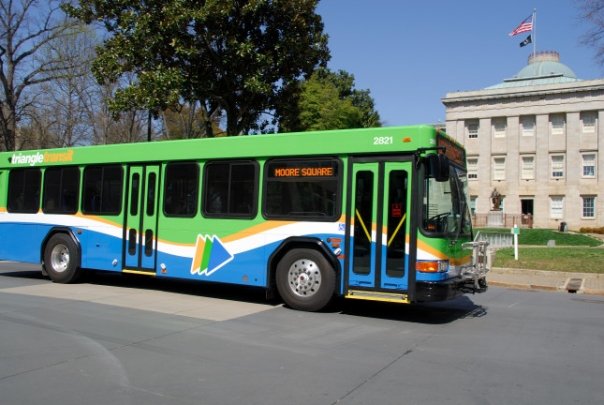Municipography is a summary of current issues going through the Raleigh City Council and other municipal departments in the city. The point is to try to deliver any video, photos, and text associated with the discussions happening at City Hall or elsewhere. Since this is a downtown Raleigh blog, the focus is on the center of the city.
Making their way around Wake County is David King, the General Manager of Triangle Transit, and his entourage to present to all twelve of Wake’s municipalities about the Wake County transit plan. Yesterday at their February 7th city council meeting, Raleigh was given the presentation. It was meant for information only and the county is gathering feedback about the plan from citizens as well as city and town leaders.
One core point of the presentation more people need to be aware of is while light rail, commuter rail, and buses are being talked about, two plans actually exist. The “core transit” plan, as it’s called, is the plan that consists of the bus plan and the commuter rail line. It is estimated that this can be covered with local revenue sources only. The “enhanced transit” plan adds the light rail piece to the mix and King makes it clear that state and federal money would be needed to bring this addition to the area.
The feedback will determine whether county leaders put a 1/2 cent sales tax increase on the ballot one day and if voters approve, all the money generated gets funneled to transit these improvements. Here is the video of the presentation in Raleigh with David King and David Cooke, the Wake County Manager, talking transit, money, and future projections.
Here’s a summary from the city’s press release.
A draft plan that recommends major transportation improvements in Wake County, including new commuter and light-rail services, was presented today to the Raleigh City Council.
Wake County Manager David Cooke and David King, general manager of the Triangle Transit Authority, appeared at the City Council meeting to give an overview of the draft Wake County Transit Plan. In addition to Wake County, contributors to the proposed plan were the 12 municipalities in the county, including the City of Raleigh, and area transit providers and agencies.
Raleigh City Council members did not take action on the draft Wake County Transit Plan but accepted it as information. Similar presentations about the draft transit plan are being made to the governing bodies of the county’s other municipalities. Wake County expects to finalize the plan late this spring.
The draft Wake County Transit Plan takes a two-pronged approach to meeting increasing transit needs as the county continues to grow. Wake County’s population, set at about 901,000 in the 2010 U.S. Census, is projected to top 1 million by 2015 and 1.5 million by 2035. The transit plan’s two-pronged approach is:
- A Core Transit Plan that would expand local and commuter bus service and build a rush-hour 37-mile commuter rail service from Garner to Durham. It would also provide amenities such as park-and-ride lots, sidewalks, signage and bus shelters, benches and other improvements; and,
- An Enhanced Transit Plan that would build light-rail service from Downtown Cary through Downtown Raleigh, up to Millbrook Road in north Raleigh. The route would cover 13.9 miles.
Wake County’s share of the of the five-year bus services improvements in the plan would be $138.3 million of the total $344 million needed for both capital and operating costs. The remaining funds would come from state and federal funds. The commuter rail service would cost $650 million, with Wake County’s share at $330 million and Durham County’s at $320 million. The commuter rail system is projected to begin operations in 2019 or 2020.
Twelve (12) stations are proposed for the commuter rail system, including four in Raleigh. The four Capital City stations would be located along railroad tracks at the following locations:
- West Raleigh north of Hillsborough Street near Corporate Center Drive;
- North Carolina State University;
- Downtown Raleigh near West and Davie Streets; and,
- Hammond Road/Rush Street area in south Raleigh
The proposed light-rail service would cost $1.1 billion, with most of the funding coming from state and federal sources. The light-rail system would have 16 stations, including 14 stations in Raleigh. The Raleigh station locations would be:
- West Raleigh Station near Corporate Center Drive and Chapel Hill Road;
- Jones Franklin Road Station;
- State Fairgrounds Station;
- Gorman Street Station;
- North Carolina State University/Dan Allen Drive Station;
- North Carolina State University/Pullen Road Station;
- West Morgan Street Station;
- Union Station-Morgan/Hargett Station in Downtown Raleigh;
- Harrington Avenue Station between Lane and Jones streets in Downtown Raleigh;
- Peace Street Station;
- Whitaker Mill Road Station;
- Six Forks Road Station;
- New Hope Church Road Station; and,
- Millbrook Road Station.
Local revenue sources to pay for the transportation improvements proposed in the draft Wake County Transit Plan would include:
- A half-cent sales tax increase which would need approval by Wake County voters in a referendum. The Wake County Board of County Commissioners would schedule the referendum; and,
- A $10 increase in annual vehicle registration fees. County commissioners have the authority to establish a new $7 vehicle registration fee, with the revenue going toward funding the transit plan. The board of trustees of Triangle Transit can increase the regional vehicle registration fee by $3 also to fund the transit plan. The current annual vehicle registration fee in Raleigh is $35. A $10 increase would raise the fee to $45.
To view the draft Wake County Transit Plan, visit the county’s website at www.wakegov.com and type “Wake County Transit Plan” in the search engine, or call 856-6160.




